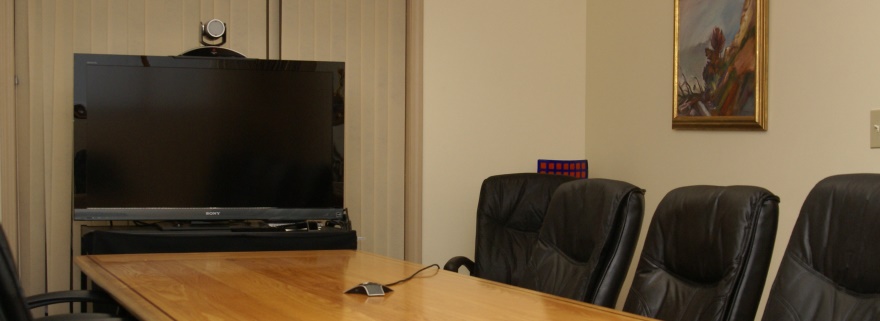We started offering videoconferencing to our court reporting clients in 2005. Since then the connections have improved and the costs have plummeted. Certainly face-to-face interaction is the best, but videoconferencing can be a pretty good second-best alternative, especially when you consider the expense of travel — not to mention the lost time.
In this article, we’ll discuss the different types of videoconferencing available for your depositions and other legal conferencing needs.
Traditional Videoconferencing
Traditional videoconferencing connects participants through a videoconference camera and a television. For example, our system is a Polycom HDX 7000 with a 46″ high-definition television, and the quality of the conference can be outstanding provided the equipment at the other end is equally good and you have a high-speed connection.

How much does traditional videoconferencing cost?
Videoconference charges are calculated based on hourly rental rates at all locations involved in the conference. Rental rates vary significantly. Our room rents for $100 per hour. A room in Dubai may run $450 per hour — or more!
If you are connecting more than two locations or if you are connecting an IP system to an ISDN system, you will have bridging costs as well. Again, bridging costs vary depending on the end points involved in the call.
What is IP and ISDN?
For inquiring minds, IP stands for Internet Protocol, and it is a way for devices to find each other via software addresses. ISDN (Integrated Services Digital Network) is a set of standards for simultaneous digital transmission of voice, video, data, and other network services over the traditional circuits of the public switched telephone network. When we first offered videoconferencing, we provided both IP and ISDN connections. However, we dropped our ISDN line several years ago as the majority of rooms we were connecting with having either IP and ISDN connections or just IP.
Videoconferencing Preparation
It’s a good idea to get estimates for all charges ahead of time — including minimum charges. If you schedule a room for two hours, but only use it for one, you may be charged for the full reservation. Also, ask about the cancellation policy for each room you reserve.
Exhibits
It is possible to share your computer files with the videoconference participants so the participants at the other end will see your documents as you discuss them.
Videoconferencing via Computer
There are many low-cost alternatives to full-blown videoconferencing: GoToMeeting, Skype, Webex, and Google Hangouts, to mention just a few. Typically the picture is not as clear and frequently the audio connection echoes or is garbled. Oftentimes a speakerphone will be used for audio to eliminate the feedback issues.
Cameo Conferencing provides a virtual meeting room that participants can log into from their laptops via a webcam. This service is more secure than the generic video-chat services (like Skype), and you usually have a better connection. It has a built-in firewall as well as audio priority and anti-freeze technology to handle network congestion. Participants receive an invitation from the host (typically your court reporter) with log-in instructions. You can connect to tablets and smartphones in addition to laptops and desktop computers.
Testing
All videoconference connections should be tested prior to the day of the meeting, whether they are traditional videoconference systems or connections through a virtual room. Be sure to arrange for a test far enough in advance to allow for trouble-shooting the connection. Relying on a test 30 minutes before the deposition is risky! There is typically no charge for the test call.
Recording a Videoconference
Many videoconference rooms have the ability to record either the near side or the far side of the conference onto a DVD. This may be useful if you need to share the conference later with other members of your team or if you want to present it during trial. However, most videoconferences are not recorded this way, so if you want a recording, be sure to make that clear when you make the reservation. It is also important to include the fact that a recording is being made in your deposition notice.
Ultimately the decision to use videoconferencing as opposed to traveling has to be made based on the relative costs and the often intangible value of face-to-face communication. If you haven’t used videoconferencing before, give it a try!
If you’d like for us to handle your next videoconference, schedule here.
In order to avoid last-minute deposition scheduling problems, download our Deposition Scheduling Report and Checklist.